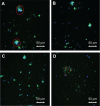Reduced adhesion of macrophages on anodized titanium with select nanotube surface features
- PMID: 21980239
- PMCID: PMC3184936
- DOI: 10.2147/IJN.S22763
Reduced adhesion of macrophages on anodized titanium with select nanotube surface features
Abstract
One of the important prerequisites for a successful orthopedic implant apart from being osteoconductive is the elicitation of a favorable immune response that does not lead to the rejection of the implant by the host tissue. Anodization is one of the simplest surface modification processes used to create nanotextured and nanotubular features on metal oxides which has been shown to improve bone formation. Anodization of titanium (Ti) leads to the formation of TiO(2) nanotubes on the surface, and the presence of these nanotubes mimics the natural nanoscale features of bone, which in turn contributes to improved bone cell attachment, migration, and proliferation. However, inflammatory cell responses on anodized Ti remains to be tested. It is hypothesized that surface roughness and surface feature size on anodized Ti can be carefully manipulated to control immune cell (specifically, macrophages) responses. Here, when Ti samples were anodized at 10 V in the presence of 1% hydrofluoric acid (HF) for 1 minute, nanotextured (nonnanotube) surfaces were created. When anodization of Ti samples was carried out with 1% HF for 10 minutes at 15 V, nanotubes with 40-50 nm diameters were formed, whereas at 20 V with 1% HF for 10 minutes, nanotubes with 60-70 nm diameters were formed. In this study, a reduced density of macrophages was observed after 24 hours of culture on nanotextured and nanotubular Ti samples which were anodized at 10, 15, and 20 V, compared with conventional unmodified Ti samples. This in vitro study thus demonstrated a reduced density of macrophages on anodized Ti, thereby providing further evidence of the greater efficacy of anodized Ti for orthopedic applications.
Keywords: TiO2 nanotube; anodization; titanium implants.
Figures



Similar articles
-
Surface nanotopography-induced favorable modulation of bioactivity and osteoconductive potential of anodized 3D printed Ti-6Al-4V alloy mesh structure.J Biomater Appl. 2018 Mar;32(8):1032-1048. doi: 10.1177/0885328217748860. Epub 2017 Dec 17. J Biomater Appl. 2018. PMID: 29249195
-
TiO2 nanotubes functionalized with regions of bone morphogenetic protein-2 increases osteoblast adhesion.J Biomed Mater Res A. 2008 Feb;84(2):447-53. doi: 10.1002/jbm.a.31388. J Biomed Mater Res A. 2008. PMID: 17618492
-
Anodizing color coded anodized Ti6Al4V medical devices for increasing bone cell functions.Int J Nanomedicine. 2013;8:109-17. doi: 10.2147/IJN.S36203. Epub 2013 Jan 4. Int J Nanomedicine. 2013. PMID: 23319862 Free PMC article.
-
A review of TiO2 NTs on Ti metal: Electrochemical synthesis, functionalization and potential use as bone implants.Mater Sci Eng C Mater Biol Appl. 2017 Jul 1;76:1401-1412. doi: 10.1016/j.msec.2017.02.150. Epub 2017 Mar 3. Mater Sci Eng C Mater Biol Appl. 2017. PMID: 28482507 Review.
-
Applications of Titania Nanotubes in Bone Biology.J Nanosci Nanotechnol. 2015 Feb;15(2):939-55. doi: 10.1166/jnn.2015.9771. J Nanosci Nanotechnol. 2015. PMID: 26353600 Review.
Cited by
-
Nanotubular TiO2 regulates macrophage M2 polarization and increases macrophage secretion of VEGF to accelerate endothelialization via the ERK1/2 and PI3K/AKT pathways.Int J Nanomedicine. 2019 Jan 10;14:441-455. doi: 10.2147/IJN.S188439. eCollection 2019. Int J Nanomedicine. 2019. PMID: 30666106 Free PMC article.
-
Decreased bacteria activity on Si₃N₄ surfaces compared with PEEK or titanium.Int J Nanomedicine. 2012;7:4829-40. doi: 10.2147/IJN.S35190. Epub 2012 Sep 7. Int J Nanomedicine. 2012. PMID: 22973102 Free PMC article.
-
Mixed oxide nanotubes in nanomedicine: A dead-end or a bridge to the future?Ceram Int. 2021 Feb 1;47(3):2917-2948. doi: 10.1016/j.ceramint.2020.09.177. Epub 2020 Sep 24. Ceram Int. 2021. PMID: 32994658 Free PMC article. Review.
-
Fabrication of Ni-Ti-O nanotube arrays by anodization of NiTi alloy and their potential applications.Sci Rep. 2014 Dec 18;4:7547. doi: 10.1038/srep07547. Sci Rep. 2014. PMID: 25520180 Free PMC article.
-
Application of anodized titanium for enhanced recruitment of endothelial progenitor cells.Nanoscale Res Lett. 2012 Jun 7;7(1):298. doi: 10.1186/1556-276X-7-298. Nanoscale Res Lett. 2012. PMID: 22676440 Free PMC article.
References
-
- Khang D, Liu-Snyder P, Pareta R, Lu J, Webster TJ. Reduced responses of macrophages on nanometer surface features of altered alumina crystalline phases. Acta Biomaterialia. 2009;5:1425–1432. - PubMed
-
- Dalton BA, McFarland CD, Underwood PA, Steele JG. Role of heparin binding domain of fibronectin in attachment and spreading of human bone-derived cells. J Cell Sci. 1995;108:2083–2092. - PubMed
-
- Wilson CJ, Clegg RE, Leavesley DI, Pearcy MJ. Mediation of biomaterial–cell interactions by adsorbed proteins: a review. Tissue Eng. 2005;11:1–18. - PubMed
-
- Webster TJ, Siegel RW, Bizios R. Osteoblast adhesion on nanophase ceramics. Biomaterials. 1999;20:1221–1227. - PubMed
-
- Webster TJ, Ergun C, Doremus RH, Siegel RW, Bizios R. Enhanced functions of osteoblasts on nanophase ceramics. Biomaterials. 2000;21:1803–1810. - PubMed
Publication types
MeSH terms
Substances
LinkOut - more resources
Full Text Sources
Research Materials
Miscellaneous

